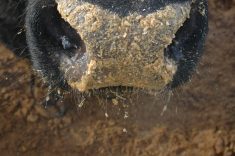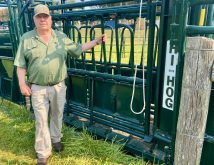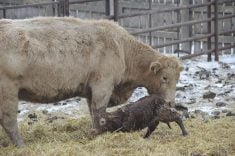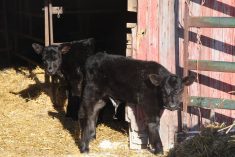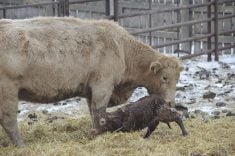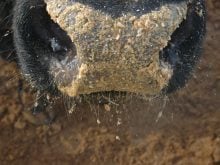A physical examination includes scrotal circumference measurement, semen quality test and checking sperm appearance
Semen quality, conformation, soundness and a desire to breed cows all play a role in bull fertility and breeding ability.
A breeding soundness examination can ensure all is well before breeding season begins. Such exams include physical and reproductive tract soundness, scrotal circumference, percentage of normal sperm cells and sperm motility.
Dr. Colin Palmer of the University of Saskatchewan says veterinarians follow specific steps in a breeding soundness exam.
Though it takes only one sperm to fertilize an egg, a bull must have many healthy sperm to be fertile. Some bulls are sub-fertile; they can get a cow pregnant but may not be able to successfully impregnate a large number.
Producers typically have a bull-to-female ratio of about one to 25 or 30, depending on size of the breeding pasture, age and number of bulls. A yearling bull may not be very fertile because it is not mature at the time of the evaluation so it will need a re-check before being put out with cows.
“We categorize bulls as satisfactory potential breeders, questionable, decision deferred or unsatisfactory,” says Palmer.
“Most reports say that one in five bulls is less than satisfactory, based on physical inspection and semen analysis. Over the years of testing bulls in many community pastures, we would often fail 20 percent of the bulls.”
In one study another 20 percent were unable to mount and complete service. Some of those bulls were six years old and older, and fertility may be lower in older bulls.
A 2010 study showed results from breeding soundness exams on 2,990 bulls in Western Canada, looking at Simmental, Angus, Hereford and Charolais bulls in 205 herds that were evaluated twice in two years. Roughly 80 percent of these bulls were between one and four years old.
“In this study, the percentage of normal sperm was lower in bulls with scrotal circumference of 34 centimetres or less. Cows exposed to bulls with smaller scrotal circumferences were less likely to be diagnosed pregnant and had a longer interval from calving until conception. It’s best to use bulls with larger scrotal circumference,” says Palmer.
“There is a category called decision deferred. This classification is useful when evaluating young bulls intended for sale. A bull might not meet the standard and could be checked later.
“Generally, when veterinarians classify a bull as decision deferred, they are reasonably sure that the problems noted will resolve within a few weeks. It might be lameness, immaturity, poor sperm morphology due to heat or stress, etc. Unsatisfactory category is for bulls that don’t meet qualifications, and we recommend that those bulls be culled,” Palmer says.
A bull’s physical examination generally includes scrotal circumference measurement, semen quality and motility and morphology — the appearance of the sperm.
The veterinarian will evaluate at least 100 sperm and determine the proportion of normal sperm and the proportion of each abnormality.
“The final part of an evaluation is looking at sex drive and serving capacity — the bull’s desire to actually breed a cow,” says Palmer.
That must wait until breeding season when the bull is put with cows that are cycling.
Every bull should be checked every year 30 to 60 days before breeding season, advises Palmer. Conformation is particularly important in young bulls, and in older bulls, injuries to claws, feet, legs, eyes and back can be issues.
“We check for pigeon toes, cow hocks, buck-kneed or calf-kneed, or posty hind legs. Those bulls won’t hold up as well when trying to breed cows,” Palmer says.
“We examine the scrotum and its contents and measure scrotal circumference as an indication of puberty and sperm production/storage capacity. In Canada we assess scrotal circumference by breed and age. For example, a 12-month-old Angus should have a minimum circumference of 32 cm.”
The sheath is inspected for conformation and normal appearance. Any swelling may be due to a prolapsed prepuce or broken penis. A common problem is injury to the prepuce, and sometimes there are lesions on the scrotum if the preceding winter was cold.
The scrotum is examined for conformation and symmetry. Testicles are palpated to see if they are normal, and the penis is checked for corkscrew or warts. Some abnormalities make it impossible for a bull to penetrate a cow.
“We also recommend a trans-rectal internal examination of the bull’s internal sex glands to check the prostate, seminal vesicles, ampulla of the ductus deferens and the bulbourethral gland. These must be normal,” Palmer says.

When checking semen samples, “sperm morphology is the main reason bulls fail a breeding soundness evaluation. We also check for white blood cells, which are bigger than the sperm,” Palmer says.
Sometimes the first several ejaculates are not typical of what a bull can produce, especially if it has not yet bred cows or if it has had a long period of sexual rest. Some bulls accumulate old sperm and must be collected several times to get a true picture of their semen.
As for libido, Palmer says veterinarians rely on producer observations. They might want to do some pen mating with a cow or heifer in heat before turning a new bull out with cows.
Semen quality and testicle size are not related to libido. A bull may have great semen and adequate scrotal circumference but that doesn’t mean it will breed cows.
Purebred breeders often give a one-year guarantee and replace any bull that has problems during the first breeding season.





